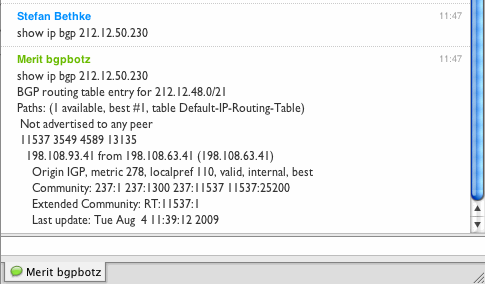If you have trouble with Flash segfaulting in Linux Firefox-3.5.2 (the symptom is a browser hang), I fixed that by downgrading Flash from Flash10 to Flash9. Of course Flash9 is full of security holes. In combination with the Flashblocker Firefox extension and only activating it on trusted sites it seems like a reasonable approach. Of course for all we know the newest Flash10 is full of security problems, too.
Monthly Archives: August 2009
Patch to vmmouse to make it work in FreeBSD
Here’s a patch to the vmmouse port that activates the driver unconditionally. This makes the VMware mouse driver work in the default configuration in FreeBSD (7 and 8).
When xorg moved to use hal by default, the vmmouse driver needed to be registered with hal. This would work fine, except for the the current port version of hal (hal-0.5.11_25) not supporting a command line option that the probe script for vmmouse needs, and the matching code that determines whether to probe for VMware never matching on FreeBSD.
The patch unconditionally activates the vmmouse driver. This should be fine even when not running in VMware, as vmmouse should be compatible with the default xorg mouse driver.
FreeBSD ppp(8): work around invalid remote address
When connecting via a Huawai E169 UTMS USB stick through O2 Germany’s network, the data stick or the network suggests a PPP IPCP remote address of 0.0.0.0. FreeBSD refuses to ifconfig the tun interface with this endpoint address.
Fortunately, ppp(8) offers a configuration parameter to influence the IP addresses negotiated with the peer (ifaddr), and suggesting a different address will make the configuration work.
If you get this log output from ppp, you need to configure address selection:
IPCP: deflink: RecvConfigAck(4) state = Req-Sent IPCP: IPADDR[6] 10.68.235.57 IPCP: PRIDNS[6] 193.189.244.197 IPCP: SECDNS[6] 193.189.244.205 IPCP: deflink: State change Req-Sent --> Ack-Rcvd IPCP: deflink: RecvConfigReq(47) state = Ack-Rcvd IPCP: [EMPTY] IPCP: deflink: SendConfigAck(47) state = Ack-Rcvd IPCP: [EMPTY] IPCP: deflink: State change Ack-Rcvd --> Opened IPCP: deflink: LayerUp. IPCP: myaddr 10.68.235.57 hisaddr = 0.0.0.0 Warning: iface add: ioctl(SIOCAIFADDR, 10.68.235.57 -> 0.0.0.0): Destination address required Error: ipcp_InterfaceUp: unable to set ip address
Here’s my complete ppp.conf, with the ifaddr line included:
u3g: set device /dev/cuaU0.0 set speed 115200 set ifaddr 10.0.0.1/0 10.0.0.2/0 255.255.255.0 set authname internet set authkey internet set log local phase ipcp set dial "ABORT BUSY TIMEOUT 2 \ \"\" \ AT OK-AT-OK \ AT+CFUN=1 OK-AT-OK \ AT+CMEE=2 OK-AT-OK \ AT+CSQ OK \ AT+CGDCONT=1,\\\"IP\\\",\\\"internet\\\" OK \ AT+CGACT? OK-AT-OK \ AT+CGATT? OK \ AT+CGCLASS? OK \ AT+COPS? OK \ ATD*99***1# CONNECT" set crtscts on nat enable yes add default HISADDR disable dns
This applies to both 7-stable and 8-stable (with both the old and the new USB stacks). I’ve used u3g(4) on both occasions. The original ppp.conf for 3G modems is based off this one from Nick Hibma.
This is how it looks like when using ifaddr:
IPCP: PRIDNS[6] 10.11.12.13 IPCP: SECDNS[6] 10.11.12.14 IPCP: PRINBNS[6] 10.11.12.13 IPCP: MS NBNS req 130 - NAK?? IPCP: SECNBNS[6] 10.11.12.14 IPCP: MS NBNS req 132 - NAK?? IPCP: deflink: SendConfigReq(2) state = Req-Sent IPCP: IPADDR[6] 10.0.0.1 IPCP: COMPPROTO[6] 16 VJ slots with slot compression IPCP: deflink: RecvConfigReq(50) state = Req-Sent IPCP: [EMPTY] IPCP: deflink: SendConfigNak(50) state = Req-Sent IPCP: IPADDR[6] 10.0.0.2 IPCP: deflink: RecvConfigRej(2) state = Req-Sent IPCP: COMPPROTO[6] 16 VJ slots with slot compression IPCP: deflink: SendConfigReq(3) state = Req-Sent IPCP: IPADDR[6] 10.0.0.1 IPCP: deflink: RecvConfigNak(3) state = Req-Sent IPCP: IPADDR[6] 10.42.237.110 IPCP: IPADDR[6] changing address: 10.0.0.1 --> 10.42.237.110 IPCP: deflink: SendConfigReq(4) state = Req-Sent IPCP: IPADDR[6] 10.42.237.110 IPCP: deflink: RecvConfigAck(4) state = Req-Sent IPCP: IPADDR[6] 10.42.237.110 IPCP: deflink: State change Req-Sent --> Ack-Rcvd IPCP: deflink: RecvConfigReq(51) state = Ack-Rcvd IPCP: [EMPTY] IPCP: deflink: SendConfigAck(51) state = Ack-Rcvd IPCP: [EMPTY] IPCP: deflink: State change Ack-Rcvd --> Opened IPCP: deflink: LayerUp. IPCP: myaddr 10.42.237.110 hisaddr = 10.0.0.2 PPP ON freebsd-current>
Les Paul
Nun hat’s auch Les Paul erwischt. Nein, es handelt sich nicht um eine Gitarre, sondern um deren Erfinder. Außerdem verdankt man ihm das Mehrspur-Tonaufnahme-Verfahren, indem er zahllose Bandmaschinen zusammenschaltete und synchron laufen ließ, sowie – und daher auch sein Ruhm – die Solid-Body-Gitarre. Les Paul ist just im Alter von 94 Jahren gestorben.
Ein schöner Nachruf auf Spiegel-Online
Hier eins seiner berühmtesten Musikstücke, gespielt mit seinem unverwechselbaren Gitarrenspiel und wiedergegeben im 24-Spur-Verfahren plus zwei Live-Spuren (Video auf Youtube)
Hedy Lamarr co-invented spread spectrum
Hollywood actress Hedy Lamarr, well known for Boom Town and My Favorite Spy, co-invented frequency hopping to help make radio controlled torpedoes more resilient:
At a party in Hollywood, Lamarr met George Antheil, an avant-garde composer who also wrote film scores. While playing the piano with the composer, the actress suddenly has an important idea for her torpedo control system. Antheil sets up the system on 88 frequencies, as this number corresponds to the number of keys on a piano. To construct it, he employs something similar to the player piano sheet music that he used in his Ballet Mécanique.
In December 1940, the frequency-switching device developed by Lamarr and Antheil was sent to the National Inventors’ Council. A patent was awarded on August 11, 1942. The two inventors leave it to the American military to figure out how to use the device. Lamarr’s and Antheil’s Secret Communication System disappears into the U.S. Army’s filing cabinets.
Ugh, what connector is that?
Over at deviantart, Sonic840 has put together a poster of I/O ports, CPU sockets, RAM modules and whatnot. Might come in handy when trying to find out what that box on Andreas’ attic is 🙂
Simon’s Cat
Wie wir gestern abend nochmal diskutiert haben…gibt’s neuere Folge von Simon’s Cat:
Chat up BGP
Telnet too complicated? Just add bgpbotz to your AIM friends list, and ask Merit’s routeviews server anything about their world view. The poor thing has a second personality answering to Jabber’s bgpbotz@jabber.merit.edu.

